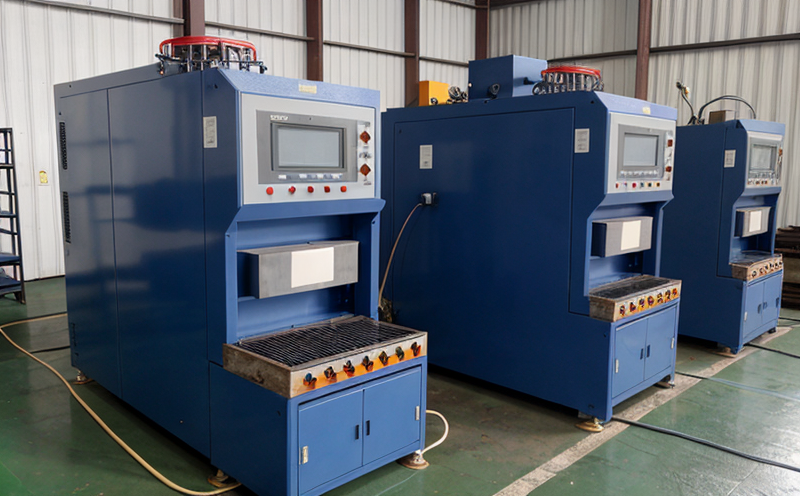DIN 38402 Trace Elements in Chemical Inputs Testing
The DIN 38402 standard is a widely recognized method used to determine trace elements in chemical inputs, ensuring high-quality raw materials and components for industrial manufacturing processes. This testing service is crucial for quality managers, compliance officers, R&D engineers, and procurement teams who need to ensure the purity of their chemical inputs.
The DIN 38402 standard covers a wide range of trace elements that can impact product performance and safety. These include metals like aluminum (Al), antimony (Sb), arsenic (As), barium (Ba), boron (B), cadmium (Cd), chromium (Cr), copper (Cu), iron (Fe), lead (Pb), manganese (Mn), mercury (Hg), molybdenum (Mo), nickel (Ni), selenium (Se), silver (Ag), tin (Sn), vanadium (V), and zinc (Zn). Trace elements can play a significant role in the chemical composition of raw materials, affecting their performance in industrial processes.
The testing process involves several key steps. Initially, the sample is prepared according to DIN 38402 specifications. This may include dissolution techniques that ensure all trace elements are released into solution for analysis. The choice of dissolution method depends on the nature of the chemical input and can vary from acid digestion to microwave-assisted methods.
Once dissolved, the sample is typically analyzed using inductively coupled plasma mass spectrometry (ICP-MS) or atomic absorption spectroscopy (AAS). These techniques provide high sensitivity and accuracy for detecting trace elements. ICP-MS offers the advantage of being able to measure multiple elements simultaneously with high precision, while AAS provides a cost-effective alternative for specific element analysis.
The results from these analyses are then compared against specified limits defined in DIN 38402. These limits ensure that trace elements do not exceed levels that could degrade product quality or lead to safety concerns. Compliance with these standards is crucial, especially in sectors where purity and consistency of raw materials are paramount.
Industries that rely heavily on chemical inputs for their manufacturing processes benefit greatly from this testing service. For instance, pharmaceutical manufacturers need to ensure that their active ingredients have no harmful trace elements. Similarly, electronic component manufacturers must guarantee the purity of metals used in circuit board production. The precision and reliability offered by DIN 38402 testing services are essential for maintaining product quality and safety.
Another critical aspect is the international acceptance and recognition of these tests. Laboratories certified to perform DIN 38402 testing are recognized globally, ensuring that results are widely accepted across borders. This standardization enhances supply chain efficiency by providing consistent quality assurance measures. Compliance with this standard can also enhance a company's reputation in global markets.
Let us delve deeper into the specific steps involved in conducting DIN 38402 tests:
- Sample Preparation: Dissolution methods are selected based on the chemical composition of the input. Common techniques include acid digestion and microwave-assisted dissolution.
- Analytical Methods: Both ICP-MS and AAS are used for accurate quantification of trace elements.
- Analysis Comparison: Results from these analyses are compared against the specified limits defined in DIN 38402 to ensure compliance.
The precision and reliability offered by DIN 38402 testing services are essential for maintaining product quality and safety. Compliance with this standard can enhance a company's reputation, ensuring that their products meet the highest international standards.
Benefits
The benefits of conducting DIN 38402 Trace Elements in Chemical Inputs Testing are manifold. Firstly, it ensures high-quality raw materials and components by identifying trace elements that could otherwise degrade product performance or lead to safety concerns.
Secondly, compliance with this standard enhances a company's reputation, making them more competitive on the global stage. This is particularly important for industries like pharmaceuticals, electronics, and chemicals where purity and consistency are critical.
Thirdly, it supports supply chain efficiency by providing consistent quality assurance measures. This ensures that all parties involved in the production process can trust the integrity of their inputs.
Forth, it helps to avoid legal issues related to non-compliance with international standards. Non-compliance can lead to significant financial losses and damage to a company's reputation.
Lastly, it provides peace of mind for stakeholders who rely on the quality and safety of products produced using these chemical inputs. This is especially important for industries where product safety is paramount.
Industry Applications
DIN 38402 Trace Elements in Chemical Inputs Testing finds application across a wide range of industrial sectors, including pharmaceuticals, electronics, chemicals, and food production. Here are some specific applications:
- Pharma Manufacturing: Ensuring the purity of active ingredients to prevent contamination risks.
- Electronic Component Manufacturing: Guaranteeing that metals used in circuit board production do not contain harmful trace elements.
- Chemical Processing: Maintaining consistent quality and safety in chemical inputs for various manufacturing processes.
- Food Production: Ensuring the purity of ingredients to meet strict food safety standards.





